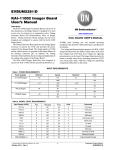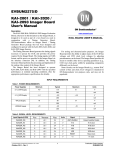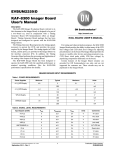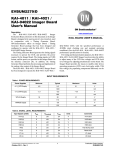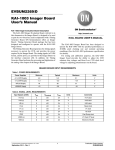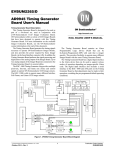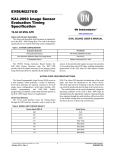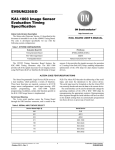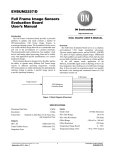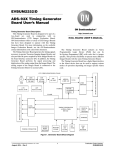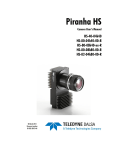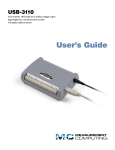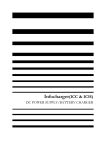Download KAF-4320 Imager Board User`s Manual
Transcript
EVBUM2253/D KAF-4320 Imager Board User's Manual Description The KAF-4320 Imager Evaluation Board, referred to in this document as the Imager Board, is designed to be part of a two−board set, used in conjunction with a Timing Generator Board. ON Semiconductor offers an Imager Board / Timing Generator Board package that has been designed and configured to operate with the KAF-4320 Image Sensor. The Timing Generator Board generates the timing signals necessary to operate the CCD, and provides the power required by the Imager Board. The timing signals, in LVDS format, and the power, are provided to the Imager Board via the interface connector (J2). In addition, the Timing Generator Board performs the processing and digitization of the analog video output of the Imager Board. The KAF-4320 Imager Board has been designed to operate the KAF-4320 with the specified performance at 3 MHz pixel clocking rate and nominal operating conditions. (See the KAF-4320 Device Specification for details). http://onsemi.com EVAL BOARD USER’S MANUAL For testing and characterization purposes, the KAF-4320 Imager Board provides the ability to adjust many of the CCD bias voltages and CCD clock level voltages by adjusting potentiometers on the board. The Imager Board provides the means to modify other device operating parameters (CCD reset clock pulse width, VSS bias voltage) by populating components differently on the board. Certain features of the Imager Board circuitry are provided for Truesense Imaging use only, and are not supported for customer use. These circuits may not be populated on the Imager Board. IMAGER BOARD INPUT REQUIREMENTS Table 1. POWER REQUIREMENTS Power Supplies Minimum Typical Maximum Units +5 V_MTR Supply 4.9 5 5.1 V 150 −5 V_MTR Supply −5.1 mA −5 −4.9 V 0 VPLUS Supply 18 mA 20 25 V 275 VMINUS Supply −21 mA −20 −18 V 150 mA Table 2. SIGNAL LEVEL REQUIREMENTS Input Signals (LVDS) Vmin Vthreshold Vmax Units Comments TIMING_OUT0 (±) 0 ±0.1 2.4 V Not Used TIMING_OUT1 (±) 0 ±0.1 2.4 V H1L clock TIMING_OUT2 (±) 0 ±0.1 2.4 V H2 clock TIMING_OUT3 (±) 0 ±0.1 2.4 V H2 clock TIMING_OUT4 (±) 0 ±0.1 2.4 V Not Used TIMING_OUT5 (±) 0 ±0.1 2.4 V Reset clock TIMING_OUT6 (±) 0 ±0.1 2.4 V V1 clock © Semiconductor Components Industries, LLC, 2014 August, 2014 − Rev. 2 1 Publication Order Number: EVBUM2253/D EVBUM2253/D Table 2. SIGNAL LEVEL REQUIREMENTS Input Signals (LVDS) Vmin Vthreshold Vmax Units Comments TIMING_OUT7 (±) 0 ±0.1 2.4 V V2 clock TIMING_OUT8 (±) 0 ±0.1 2.4 V MUX SEL0 TIMING_OUT9 (±) 0 ±0.1 2.4 V MUX SEL1 TIMING_OUT10 (±) 0 ±0.1 2.4 V Not Used TIMING_OUT11 (±) 0 ±0.1 2.4 V ALT_VDD ckt. ARCHITECTURE OVERVIEW CCD Bias Voltages The following sections describe the functional blocks of the KAF−4320 Imager Board (refer to Figure 1). The bias voltages are set by potentiometers. The bias voltages are de−coupled at the CCD pin. Power Filtering and Regulation Power is supplied to the Imager Board via the J2 board interface connector. The power supplies are de-coupled and filtered with ferrite beads and capacitors to suppress noise. Voltage regulators are used to create the +15 V, −15 V and CCD VDD supplies from the VPLUS and VMINUS power supplies input to the Imager Board. Alternate VDD Circuit LVDS Receivers / TTL Buffers This evaluation board supports the KAF−4320 Image Sensor. The CCD’s output amplifier can be turned off during the integration time by lowering the CCD’s VDD bias voltage. This is accomplished using an amplifier enabled control line sent from the Timing Generator Board. CCD Image Sensor LVDS timing signals are input to the Imager Board via the J2 interface connector. These signals are translated to TTL levels before being sent to the CCD clock drivers. Emitter−Follower The VOUT_CCD signal is buffered using a bipolar junction transistor in the emitter-follower configuration. This circuit also provides the necessary 5 mA current sink for the CCD output circuit. CCD Pixel−Rate Clock Drivers (H1, H1L, H2 & Reset Clocks) The pixel rate CCD clock drivers utilize two fast switching transistors that are designed to translate TTL−level input clock signals to the voltage levels required by the CCD. The high level and low level of the CCD clocks are set by potentiometers. Line Drivers The buffered VOUT_CCD signals are AC−coupled and driven from the Imager Board by operational amplifiers in a non−inverting configuration. The operational amplifiers are configured to have a gain of 1.25. Reset Clock One−Shot The pulse width of the RESET_CCD clock can be set by a programmable One−Shot. The One−Shot can be configured to provide a RESET_CCD clock signal with a pulse width from 5 ns to 15 ns. Alternatively, the One−Shot can be left unpopulated and bypassed by a shorting resistor. In this configuration the pulse width of the RESET_CCD clock is set by the programmable logic on the Timing Generator Board. This is the default configuration. Multiplexed VOUT Option Each of the four CCD output signals is driven from the Imager Board independently. The four CCD output signals can also be input to a 4−to−1 multiplexer circuit. The output of this circuit is driven off the Imager Board as well. In order to utilize the multiplexer circuit, four shorting resistors (R7, R8, R18 and R25) must be installed on the Imager Board. Two mux control lines sent from the Timing Generator Board select which of the four CCD outputs will be driven from the Imager Board via the output of the multiplexer circuit. CCD VCLK Drivers The vertical clock (VCLK) drivers consist of MOSFET driver IC’s. These drivers are designed to translate the TTL−level clock signals to the voltage levels required by the CCD. The high and low voltage rails of the vertical clocks are set by potentiometers. http://onsemi.com 2 EVBUM2253/D OPERATIONAL SETTINGS were correct at the time of this document’s publication, but may be subject to change; refer to the KAF−4320 device specification. The Imager board is configured to operate the KAF−4320 under the following operating conditions: Bias Voltages The following voltages are fixed, or adjusted with a potentiometer as noted. The nominal values listed in Table 3 Table 3. BIAS VOLTAGES Description Symbol Min Nom Max Units Potentiometer Notes Output Amplifier Supply VDD 15 21 21 V R104 1 Reset Drain VRD 10 18 20 V R130 4 Output Amplifier Return VSS 0.7 2.1 2.8 V − 2 Substrate SUB V fixed 3 Output Gate VOG 0.4 1 7.7 V R88 4 Lateral Drain Guard Ring VLOD 7.25 10 14.5 V R69 4 VLG 0.4 3 7.7 V R103 4 Last Gate 0 1. VDD may be switched to an alternate supply during integration; see Table 4. 2. VSS is set from 1 to 4 diode drops above AGND by populating 1-3 bypass resistors accordingly. Each resistor populated bypasses a diode. Default is 1 bypass resistor populated; therefore VSS is three diode drops above AGND. 3. VSUB is connected directly to AGND. 4. The Min and Max values shown refer to the adjustment range of the potentiometers on the Imager Board and may not be appropriate for proper device operation. For proper device operation the Nominal values should be used for all bias voltages. Clock Voltages Table 4 were correct at the time of this document’s publication, but may be subject to change; refer to the KAF−4320 device specification. The following clock voltage levels are fixed, or adjusted with a potentiometer as noted. The nominal values listed in Table 4. CLOCK VOLTAGES Description Symbol Level Min Nom Max Units Potentiometer Notes Horizontal CCD Clock – Phase 1 H1_CCD Low −7.8 0 −0.7 V R168 8 High 0 10 10 V R184 8 HCCD Last Gate Clock – Phase 1 Horizontal CCD Clock – Phase 2 H2_CCD Vertical CCD Clock – Phase 1 V1_CCD Vertical CCD Clock – Phase 2 Reset Clock VDD 5. 6. 7. 8. H1L_CCD V2_CCD RESET_CCD Low −4 V R205 8 High 6 V R204 8 8 Low −7.8 −4 −0.7 V R120 High 0 6 10 V R107 8 Low −14 −8 −5 V R57 5, 8 High 0.2 0 4.2 V R80 6, 8 Low −14 −8 −5 V R57 5, 8 High 0.2 0 4.2 V R80 6, 8 Low 0.7 2 7.8 V R194 8 High 7.25 14 14.5 V R174 8 ALT_VDD Low 5 7 10 V R158 7, 8 VDD High 15 21 21 V R104 8 V1_CCD and V2_CCD low levels are controlled by the same potentiometer (R57). V1_CCD and V2_CCD high levels are controlled by the same potentiometer (R80). Controlled by AMP_ENABLE control line. The Min and Max values shown refer to the adjustment range of the potentiometers on the Imager Board and may not be appropriate for proper device operation. For proper device operation the Nominal values should be used for all clock voltages. http://onsemi.com 3 EVBUM2253/D Reset Clock Pulse Width Alternatively, the One−Shot can be left unpopulated and bypassed by a shorting resistor. In this configuration the pulse width of the RESET_CCD clock is set by the programmable logic on the Timing Generator Board. This is the default configuration. The pulsewidth of the RESET_CCD clock can be set by configuring the inputs to the programmable one−shot, P[2..0]. P[2..0] can be tied either high or low to achieve the desired pulse width by populating the resistors R192, R193, R200, and R201 accordingly. Table 5. RESET CLOCK PULSE WIDTH Pulse Width P2 P1 P0 R192 R193 R200 R201 15 ns 0 0 5 ns 0 0 0 IN OUT IN OUT 1 OUT IN IN OUT 7.5 ns 0 1 0 IN OUT OUT IN 10 ns 0 1 1 OUT IN OUT IN Set by Timing Generator Board Notes Default Configuration Multiplexed VOUT Channel Select video output leaving the Imager Board. The overall system performance may be affected when the CCD video outputs are connected to the multiplexer circuit. Any one of the four CCD VOUT signals can be selected and driven off the Imager Board via the multiplexed output SMB connector. The VOUT channel selection is controlled by the MUX[1..0] control line inputs from the Timing Generator Board. If it is desired to utilize the 4:1 multiplexer circuit on the Imager Board, shorting resistors R7, R8, R18 and R25 must first be installed to connect the CCD video outputs to the multiplexer inputs. The multiplexer circuit presents a capacitive load to the video driver amplifiers of approximately 200 pF. This capacitive load will limit the bandwidth and slow down the transitioning of the CCD Table 6. MULTIPLEXED VOUT CHANNEL SELECTION MUX0 MUX1 VOUT MUX Notes 0 0 VOUT3 Default Setting 1 0 VOUT2 0 1 VOUT4 1 1 VOUT1 http://onsemi.com 4 EVBUM2253/D BLOCK DIAGRAM AND PERFORMANCE DATA VDD BIAS ADJUSTMENT POT VOUT[3..0] CCD BIAS VOLTAGE ADJUSTMENT POTS EMITTER FOLLOWERS LINE DRIVERS ALTERNATE VDD SWITCH VOUT MUX VOUT[3..0] V1 DRIVER VCLKS LEVEL ADJUST POTS H2 CLK LEVEL ADJUST POTS RCLK DRIVER 4:1 MUX CCD SENSOR V2 DRIVER RCLK 1 SHOT H2 DRIVER H1 DRIVER H1L DRIVER RESET LEVEL ADJUST POTS H1 CLK LEVEL ADJUST POTS H1L CLK LEVEL ADJUST POTS LVDS TO TTL BUFFERS +15V REGULATOR LVDS RECEIVERS -15V REGULATOR BOARD INTERFACE CONNECTOR Figure 1. KAF−4320 Imager Board Block Diagram http://onsemi.com 5 EVBUM2253/D KAF−4320 Linearity 1000000 100000 Signal (electrons/pixel) 10000 1000 measured fit 100 % dev from fit 10 1 0.1 0.01 1 10 100 1000 10000 100000 Time (msec) Figure 2. Measured Performance − Linearity Photon Transfer 100 Noise (A/D counts) Slope = el/Adu = 7.87 electrons Noise floor = 2.51 counts (19.8 electrons) LVSAT = 487657 electrons VSAT = 508709 electrons 10 10000 100000 1000000 Signal Mean (Electrons) Figure 3. Measured Performance − Dynamic Range and Noise Floor http://onsemi.com 6 EVBUM2253/D CONNECTOR ASSIGNMENTS AND PINOUTS SMB Connectors J3−6 The emitter-follower buffered CCD_VOUT signals are driven from the Imager Board via the SMB connectors J3−6. Coaxial cable with a characteristic impedance of 75 W should be used to connect the imager board to the Timing Generator Board to match the series and terminating resistors used on these boards. Table 7. J2 INTERFACE CONNECTOR PIN ASSIGNMENTS Pin Signal Pin Signal 1 N.C. 2 N.C. 3 AGND 4 AGND 5 TIMING_OUT11+ 6 TIMING_OUT11− 7 AGND 8 AGND 9 TIMING_OUT10+ 10 TIMING_OUT10− 11 AGND 12 AGND 13 TIMING_OUT9+ 14 TIMING_OUT9− 15 AGND 16 AGND 17 TIMING_OUT8+ 18 TIMING_OUT8− 19 AGND 20 AGND 21 TIMING_OUT7+ 22 TIMING_OUT7− 23 AGND 24 AGND 25 TIMING_OUT6+ 26 TIMING_OUT6− 27 AGND 28 AGND 29 TIMING_OUT5+ 30 TIMING_OUT5− 31 AGND 32 AGND 33 TIMING_OUT4+ 34 TIMING_OUT4− 35 AGND 36 AGND 37 TIMING_OUT3+ 38 TIMING_OUT3− 39 AGND 40 AGND 41 TIMING_OUT2+ 42 TIMING_OUT2− 43 AGND 44 AGND 45 TIMING_OUT1+ 46 TIMING_OUT1− 47 N.C. 48 N.C. 49 AGND 50 AGND 51 N.C. 52 N.C. 53 VMINUS_MTR 54 VMINUS_MTR 55 N.C. 56 N.C. 57 AGND 58 AGND 59 TIMING_OUT0+ 60 TIMING_OUT0− 61 −5 V_MTR 62 −5 V_MTR 63 N.C. 64 N.C. 65 AGND 66 AGND 67 N.C. 68 N.C. 69 +5 V_MTR 70 +5 V_MTR 71 N.C. 72 N.C. 73 AGND 74 AGND 75 N.C. 76 N.C. 77 VPLUS_MTR 78 VPLUS_MTR 79 N.C. 80 N.C. http://onsemi.com 7 EVBUM2253/D Warnings and Advisories Ordering Information ON Semiconductor is not responsible for customer damage to the Imager Board or Imager Board electronics. The customer assumes responsibility and care must be taken when probing, modifying, or integrating the Truesense Imaging Evaluation Board Kits. When programming the Timing Board, the Imager Board must be disconnected from the Timing Board before power is applied. If the Imager Board is connected to the Timing Board during the reprogramming of the Altera PLD, damage to the Imager Board will occur. Purchasers of a an Evaluation Board Kit may, at their discretion, make changes to the Timing Generator Board firmware. ON Semiconductor can only support firmware developed by, and supplied by, ON Semiconductor. Changes to the firmware are at the risk of the customer. Please address all inquiries and purchase orders to: Truesense Imaging, Inc. 1964 Lake Avenue Rochester, New York 14615 Phone: (585) 784−5500 E−mail: [email protected] ON Semiconductor reserves the right to change any information contained herein without notice. All information furnished by ON Semiconductor is believed to be accurate. ON Semiconductor and the are registered trademarks of Semiconductor Components Industries, LLC (SCILLC) or its subsidiaries in the United States and/or other countries. SCILLC owns the rights to a number of patents, trademarks, copyrights, trade secrets, and other intellectual property. A listing of SCILLC’s product/patent coverage may be accessed at www.onsemi.com/site/pdf/Patent−Marking.pdf. SCILLC reserves the right to make changes without further notice to any products herein. SCILLC makes no warranty, representation or guarantee regarding the suitability of its products for any particular purpose, nor does SCILLC assume any liability arising out of the application or use of any product or circuit, and specifically disclaims any and all liability, including without limitation special, consequential or incidental damages. “Typical” parameters which may be provided in SCILLC data sheets and/or specifications can and do vary in different applications and actual performance may vary over time. All operating parameters, including “Typicals” must be validated for each customer application by customer’s technical experts. SCILLC does not convey any license under its patent rights nor the rights of others. SCILLC products are not designed, intended, or authorized for use as components in systems intended for surgical implant into the body, or other applications intended to support or sustain life, or for any other application in which the failure of the SCILLC product could create a situation where personal injury or death may occur. Should Buyer purchase or use SCILLC products for any such unintended or unauthorized application, Buyer shall indemnify and hold SCILLC and its officers, employees, subsidiaries, affiliates, and distributors harmless against all claims, costs, damages, and expenses, and reasonable attorney fees arising out of, directly or indirectly, any claim of personal injury or death associated with such unintended or unauthorized use, even if such claim alleges that SCILLC was negligent regarding the design or manufacture of the part. SCILLC is an Equal Opportunity/Affirmative Action Employer. This literature is subject to all applicable copyright laws and is not for resale in any manner. PUBLICATION ORDERING INFORMATION LITERATURE FULFILLMENT: Literature Distribution Center for ON Semiconductor P.O. Box 5163, Denver, Colorado 80217 USA Phone: 303−675−2175 or 800−344−3860 Toll Free USA/Canada Fax: 303−675−2176 or 800−344−3867 Toll Free USA/Canada Email: [email protected] N. American Technical Support: 800−282−9855 Toll Free USA/Canada Europe, Middle East and Africa Technical Support: Phone: 421 33 790 2910 Japan Customer Focus Center Phone: 81−3−5817−1050 http://onsemi.com 8 ON Semiconductor Website: www.onsemi.com Order Literature: http://www.onsemi.com/orderlit For additional information, please contact your local Sales Representative EVBUM2253/D








